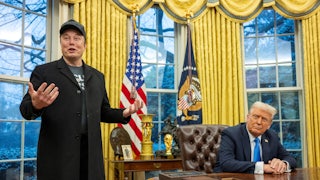Elon Musk is not a fan of unions. Nor are Amazon, Starbucks, or, apparently, Trader Joe’s. Those four companies opened the new year by mounting a legal campaign to destroy the federal agency charged with protecting workers from unfair anti-unionization efforts and maintaining labor peace. If they succeed, they could radically tip the scales in favor of corporations and away from the workers who hope to organize their workplaces.
SpaceX, the rocket company founded by Musk, asked a federal judge last month to block an imminent enforcement action against it by the National Labor Relations Board, a federal agency that monitors unfair labor practices. The company argued that the New Deal–era agency’s structure violates the Constitution and asked the courts to defang and dismantle it.
“The NLRB’s current way of functioning is miles away from the traditional understanding of the separation of powers, which views ‘[t]he accumulation of all powers legislative, executive and judiciary in the same hands’ as ‘the very definition of tyranny,’” the company said in its complaint, quoting from the Federalist Papers. While SpaceX noted that the Supreme Court has previously upheld “aspects” of the agency’s structure, “the court has subsequently clarified that the Constitution’s due process guarantee precludes an individual from serving as prosecutor and adjudicator in the same case,” it claimed.
The NLRB consists of a general counsel and five board members, all of whom are appointed by the president and serve four-year terms. The general counsel serves as a prosecutor of sorts, investigating complaints of labor law violations and pursuing charges for them before the agency’s administrative law judges, or ALJs. In addition to other responsibilities, the five-member board reviews the ALJs’ rulings in labor disputes.
SpaceX argued that the NLRB’s structure is unconstitutional in two ways. First, it claimed that the agency’s key members—the five board members and the ALJs—are “unconstitutionally insulated from removal.” The company says that certain provisions in federal law that only allow those civil servants to be fired for cause infringe upon the executive branch’s constitutional powers. (SpaceX also argued that the agency’s adjudication process violated the Seventh Amendment right to a jury trial in civil lawsuits, but we’ll come back to that later.)
The Supreme Court has been receptive to similar arguments against other federal agencies. In the 2018 case Lucia v. Securities and Exchange Commission, the justices held that the ALJs who work for the SEC are considered “inferior officers” under Article 2. That meant that the ALJs at that agency wield significant enough power that they must be hired by the president or a Senate-confirmed official to whom he delegates that authority.
As for the five board members, the justices have also taken aim at some federal regulatory agencies whose leaders can only be fired by the president for cause. In the 2020 case Selia Law v. Consumer Financial Protection Bureau, the justices struck down provisions that protected the CFPB director from being fired only for “inefficiency, neglect, and malfeasance.” At the same time, they ruled that this perceived defect did not require them to abolish the entire agency, as some parties had hoped.
“We therefore hold that the structure of the CFPB violates the separation of powers,” Chief Justice John Roberts wrote for the court. “We go on to hold that the CFPB Director’s removal protection is severable from the other statutory provisions bearing on the CFPB’s authority. The agency may therefore continue to operate, but its director, in light of our decision, must be removable by the President at will.”
SpaceX also argued that the NLRB itself was unconstitutional because the “exercise of prosecutorial, legislative, and adjudicatory authority” by the agency “violates the separation of powers and due process.” Its complaint focused on the process by which NLRB members can petition a federal district court for a preliminary injunction against alleged labor law violators. SpaceX argued that this internal process was insufficiently adversarial and thus violated the company’s due process rights.
Last week, Amazon raised similar arguments in a series of NLRB cases that it currently faces. The internet retail giant, which has its own troubled history of unfair labor practices, offered a smorgasbord of administrative law issues to fight back against the agency. It claimed the NLRB general counsel’s interpretation of the National Labor Relations Act “implicate[s] the Major Questions Doctrine”—which has become a newfangled tool developed by the Supreme Court’s conservative majority to strike down disfavored regulatory actions, as well as references to the nondelegation doctrine that some conservative justices favor.
Amazon also reiterated claims made by SpaceX in its own litigation that the NLRB itself was unconstitutional. “The structure of the NLRB violates the United States Constitution’s separation of powers and Amazon’s due process rights under the Fifth Amendment to the United States Constitution because the NLRB’s Board Members concurrently exercise legislative, executive, and judicial powers in the same administrative proceeding,” the company alleged.
Earlier this month, Starbucks also made similar claims in its own proceedings involving the NLRB. The massive coffee chain has spent the last few years battling complaints from workers and labor groups over a persistent pattern of anti-union practices, including shutting down branches where workers try to organize. The NLRB filed a complaint in December to reopen 23 of its stores that the agency said had been closed in violation of labor laws.
A few months earlier, an NLRB administrative law judge ruled that former Starbucks CEO Howard Schultz had also violated labor law by telling a worker who had raised union-related issues to him that “if you’re not happy at Starbucks, you can go work for another company,” which was interpreted as a threat of dismissal. According to The New York Times, Schultz returned to serve a third stint as the company’s CEO because he wanted to stop the unionization drive and preserve the company’s image as a “model employer.”
Musk has a long history of antipathy toward unions, and his companies have an established pattern of abusive labor practices. “I disagree with the idea of unions,” he said at an event in November. “I just don’t like anything which creates a lords and peasants sort of thing.” This is the same nonsensical phrase that he used to describe Twitter’s verification practices before he bought the company, which he then dismantled in pursuit of monetization.
Musk also claimed during the event that unions “naturally try to create negativity in a company.” While that assertion is questionable, unionization could imperil Musk’s meticulous efforts at image management and brand promotion, which have helped turn Tesla and SpaceX into multibillion-dollar companies. It would also make it harder for Musk to impose his own vision of work-life balance upon his companies’ workforces: He once claimed to work 16 hours a day, and Tesla workers have often faced similarly grueling schedules, even on weekends. His factories in California, Nevada, and Texas have also faced frequent complaints about unsafe labor practices.
SpaceX’s decision to file the lawsuit in Texas, rather than California, appeared to be a transparent bid to secure a conservative, business-friendly slate of judges to hear the case. That effort faced a major setback last week when the presiding judge ordered it transferred to federal courts in California.
“The events touching this district are incidental to the principal events occurring elsewhere and constitute a relatively small portion of the total body of events,” Judge Rolando Olvera concluded. “This action concerns a California administrative proceeding regarding the actions of a California company and its California employees in California. This action should be transferred.” The Fifth Circuit Court of Appeals stayed that transfer pending further review on Tuesday, however, and may yet give Musk the more favorable forum that he is seeking.
Whether the companies’ efforts to upend federal labor law succeed will depend on the willingness of the Supreme Court to eventually embrace them. The court’s conservative majority is not known for its friendliness to labor unions, to say the least. In recent years, the justices have ruled against fair-share fees for public-sector unions, made it harder for California farmworkers to organize, and gave companies new latitude to sue striking workers for damages.
The court is also hearing a series of cases this term that could upend how the federal government issues and enforces its own regulations. One of them, Jarkesy v. SEC, is currently challenging the for-cause provisions that protect the SEC’s ALJs from at-will firing. The parties in that case have also raised the same Seventh Amendment question raised by the companies in the SEC enforcement context, meaning that the justices will likely shed new light on that legal question soon.
Beyond the legal implications, the legal war against the NLRB is a stark signal of how far companies have moved against the laws and regulations that ended decades of violent labor strife and set the stage for America’s postwar prosperity. If the companies prevail, most working Americans will find it harder than their parents or grandparents ever did to collectively organize for better wages and conditions.










